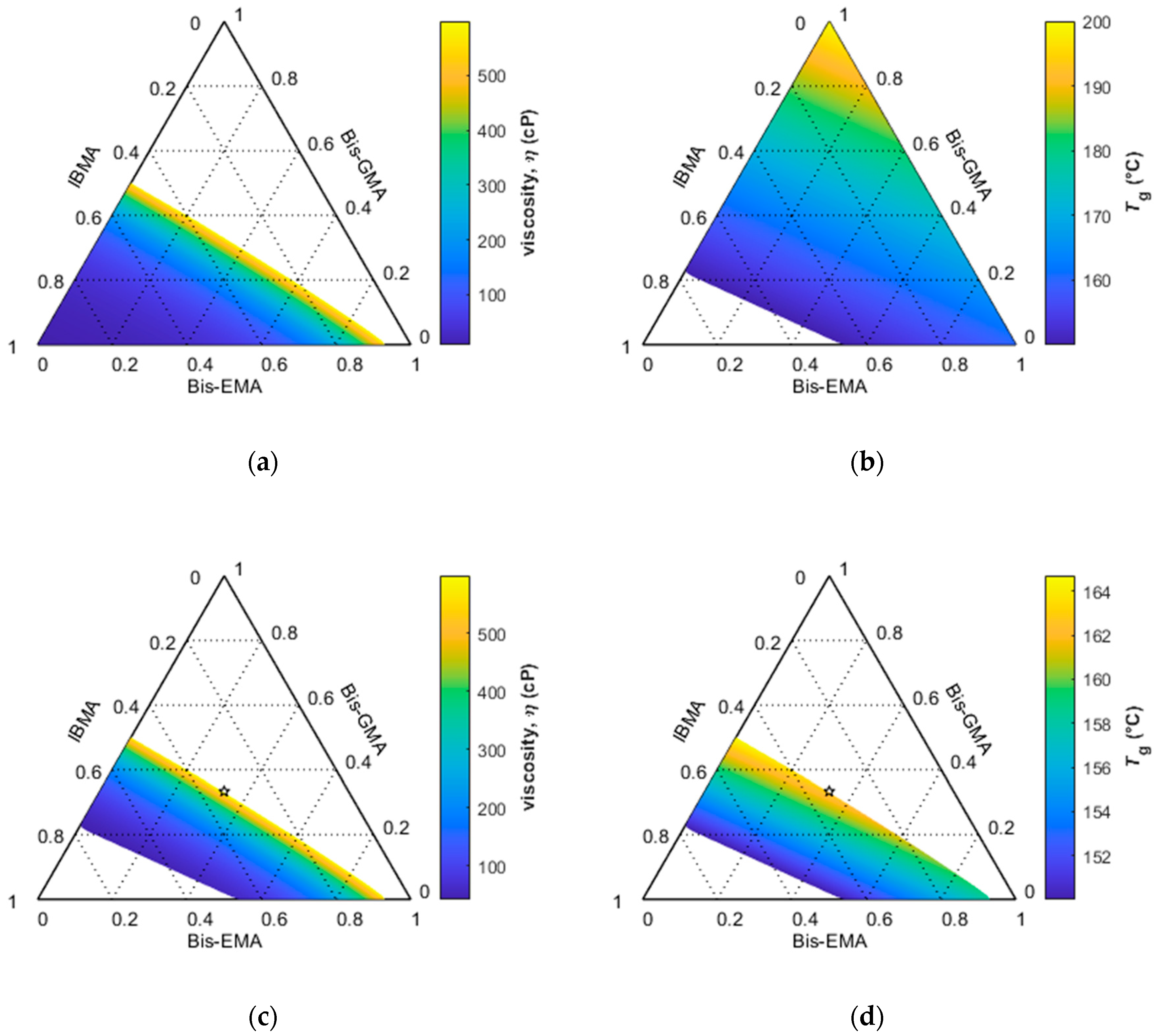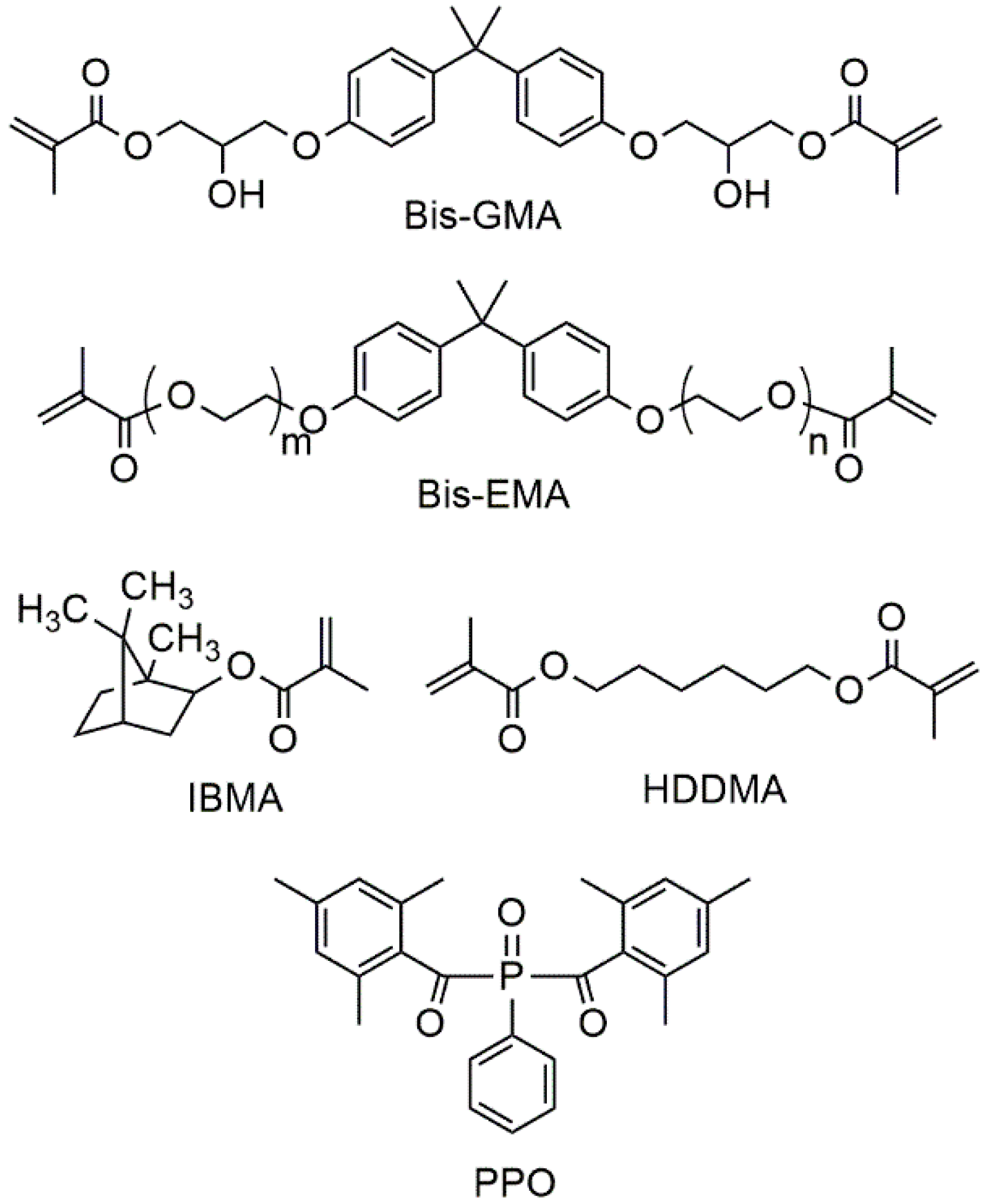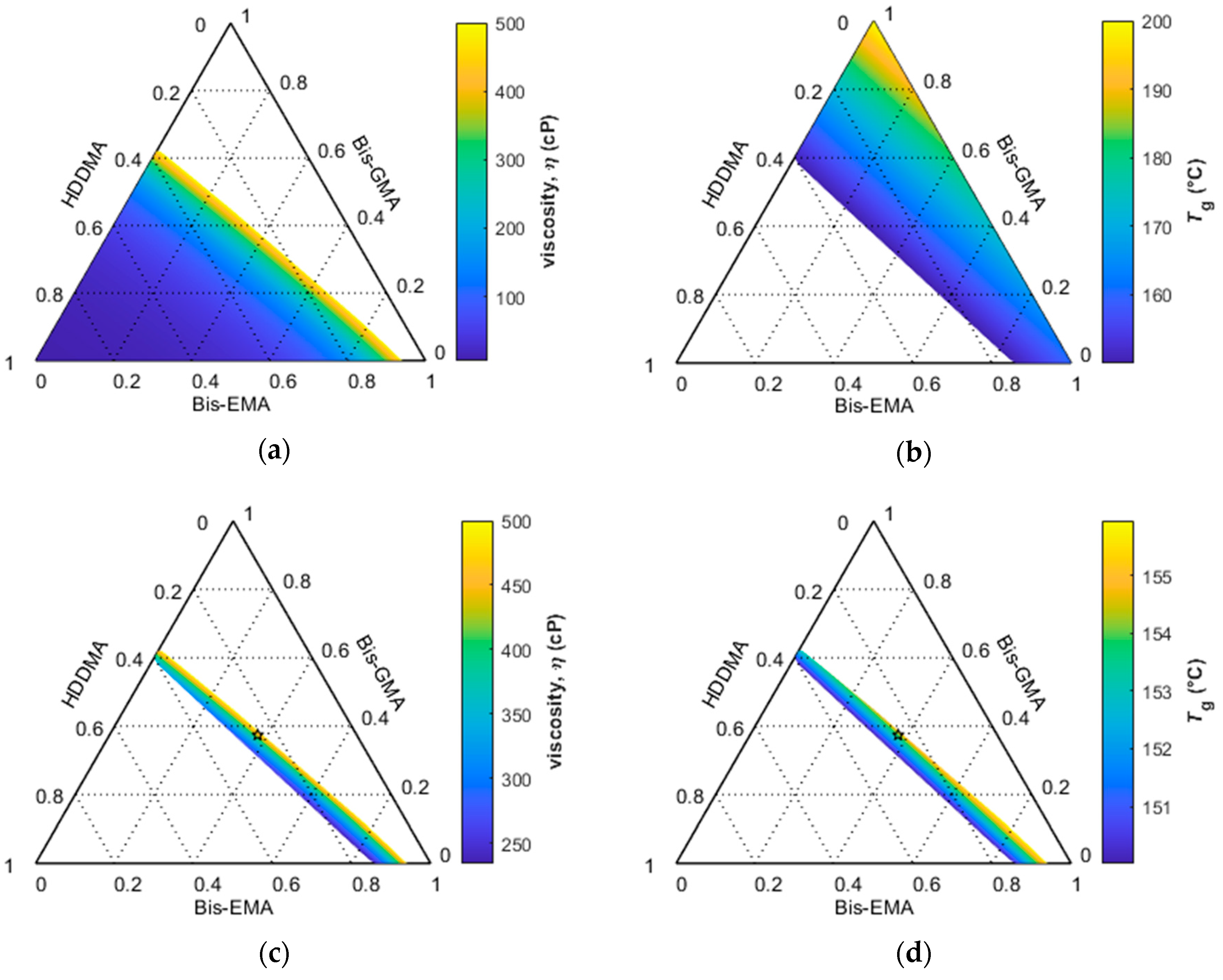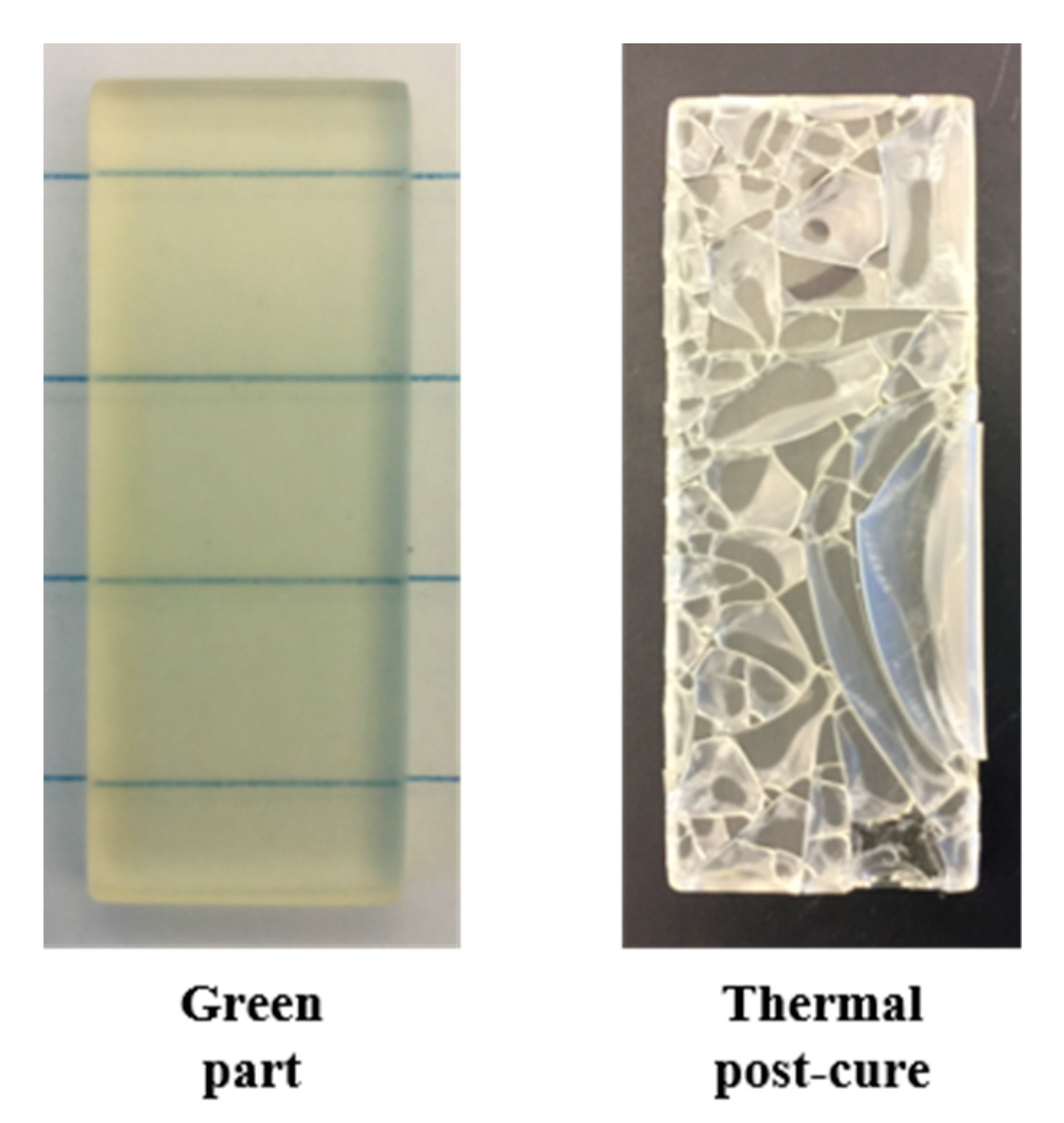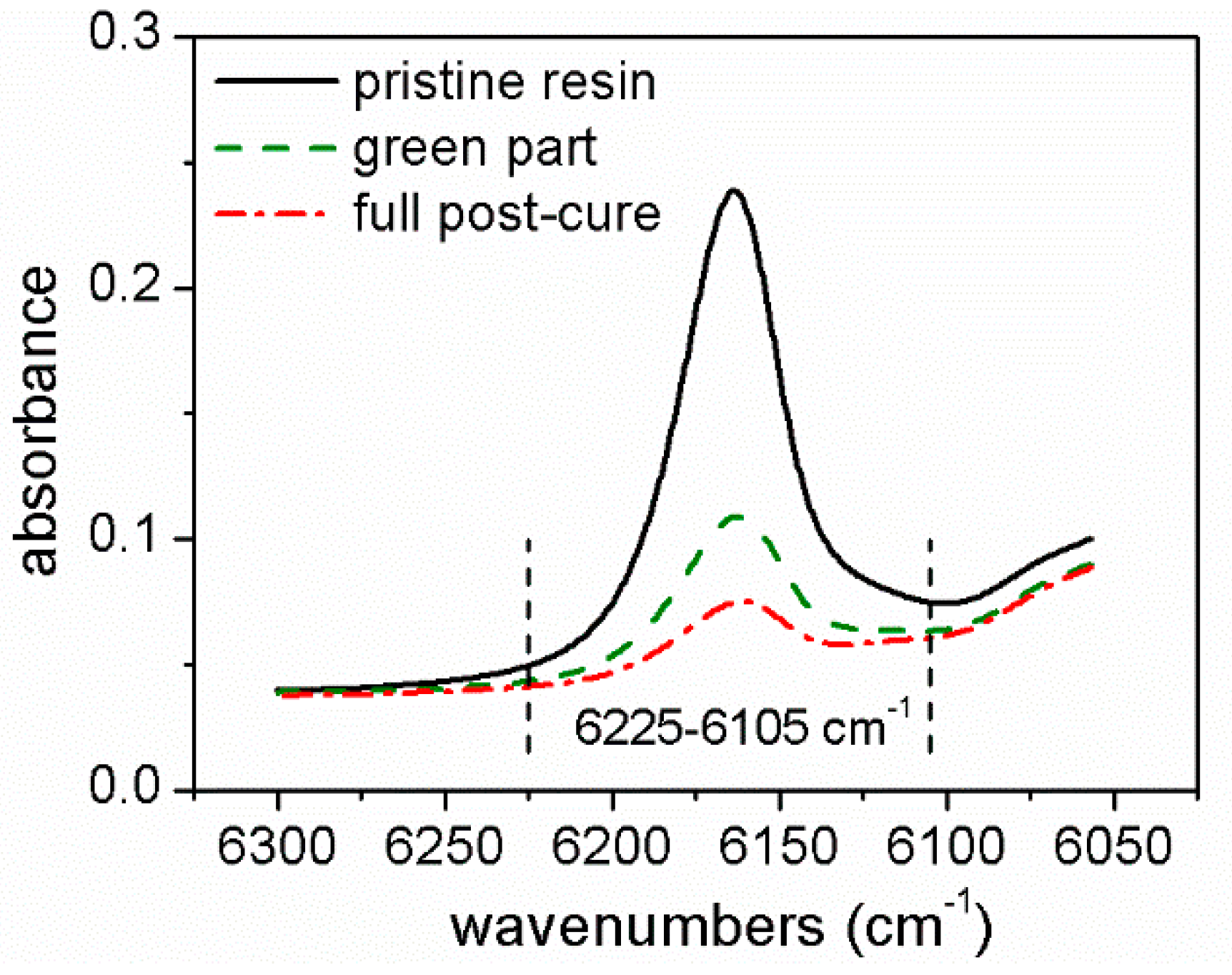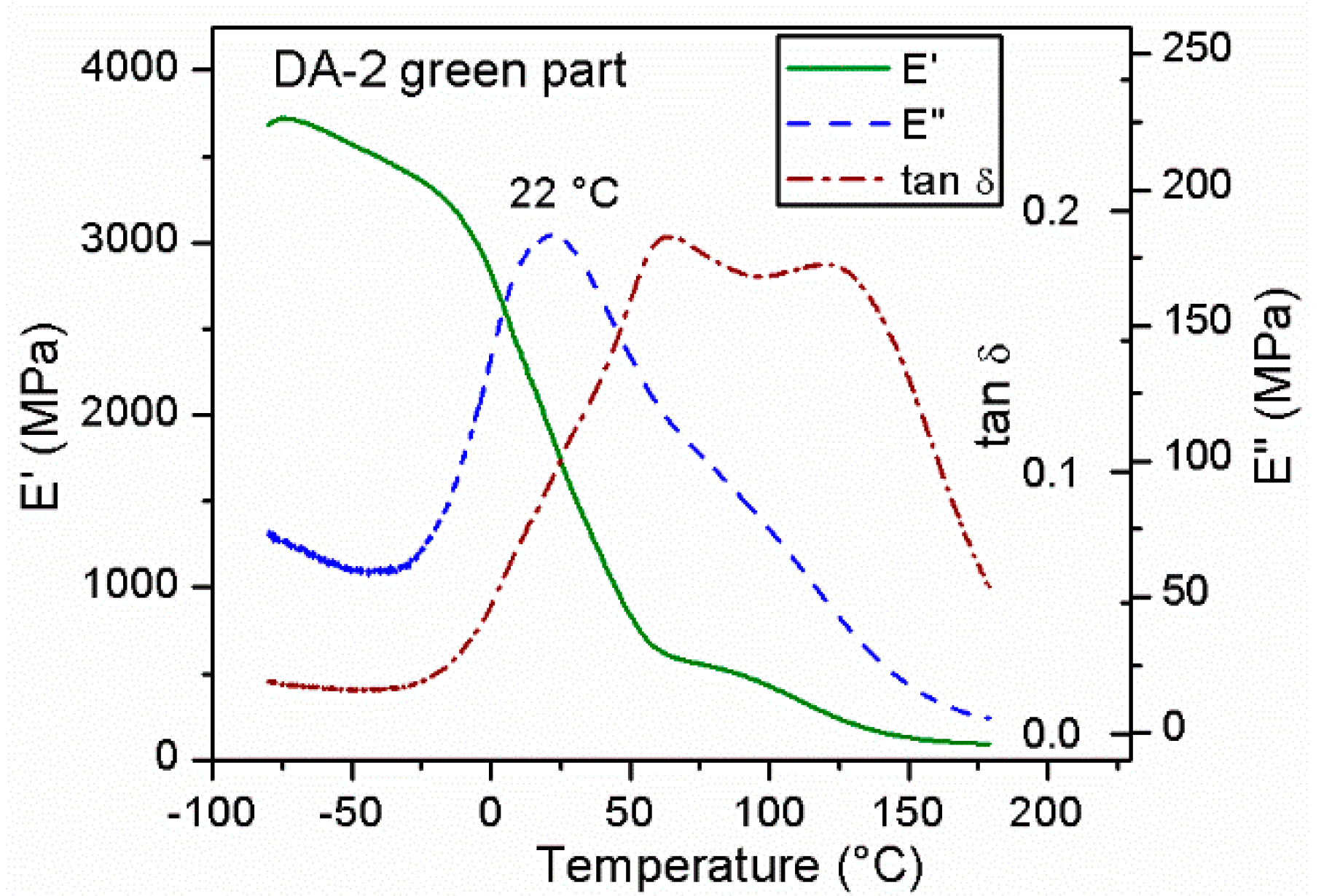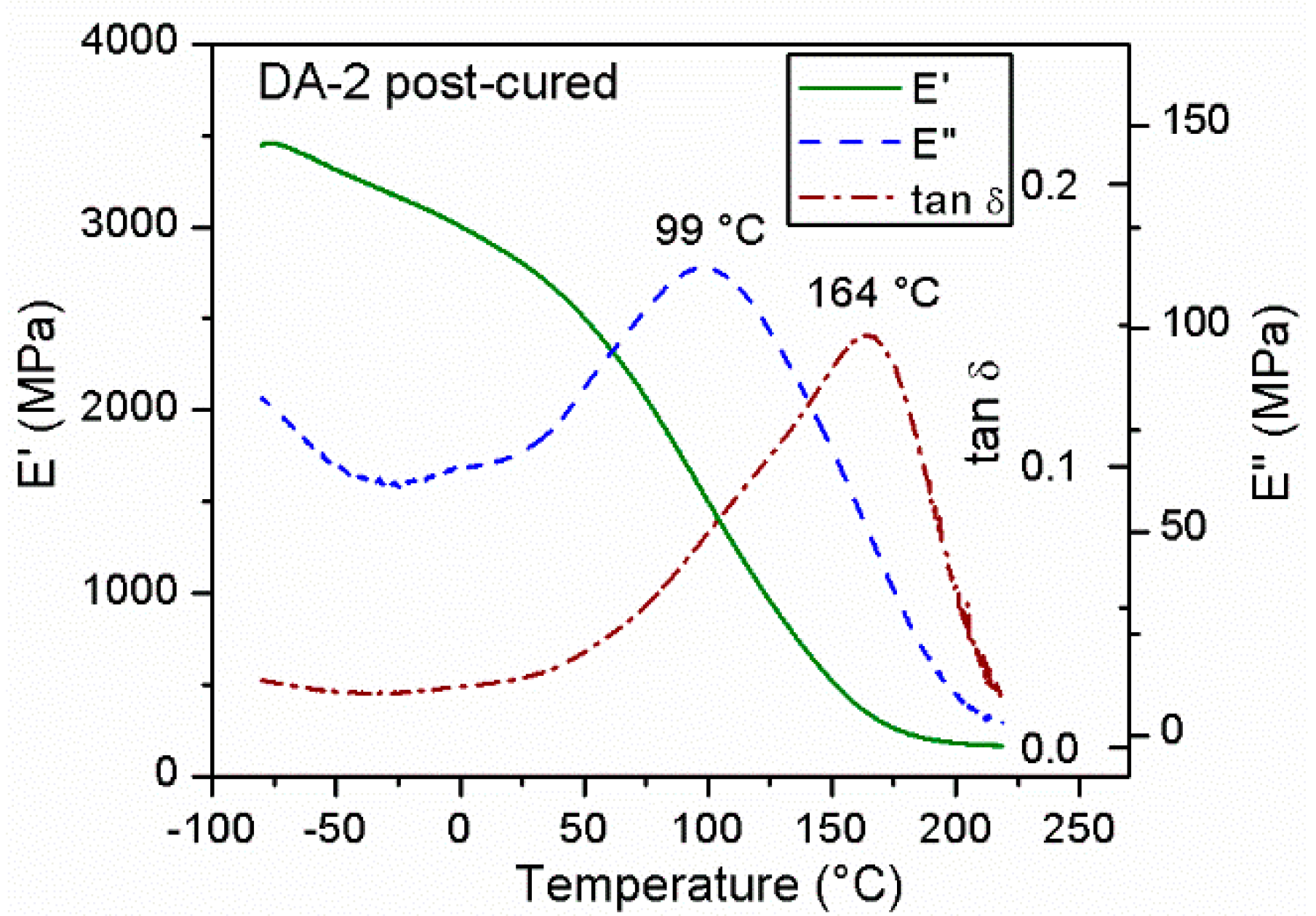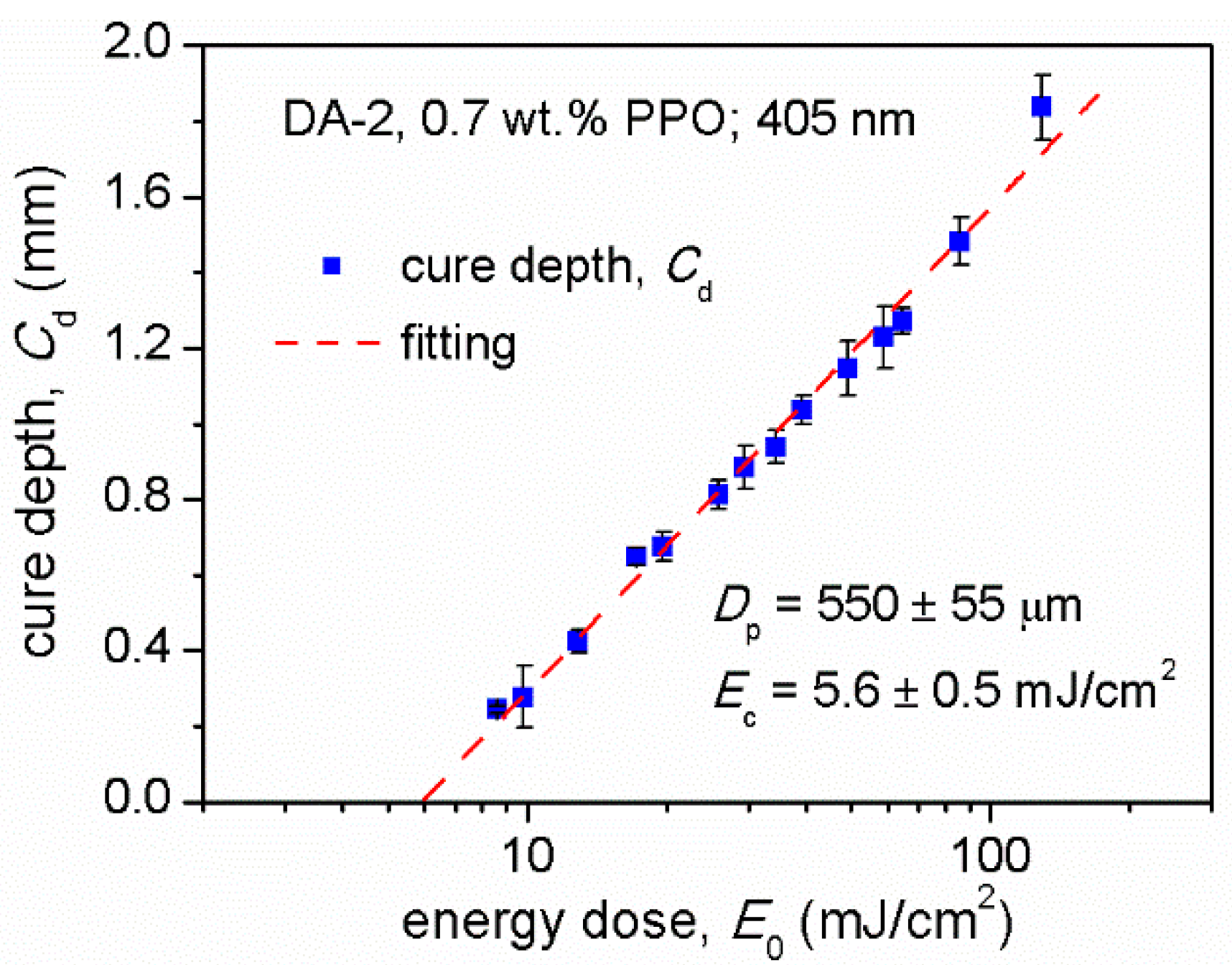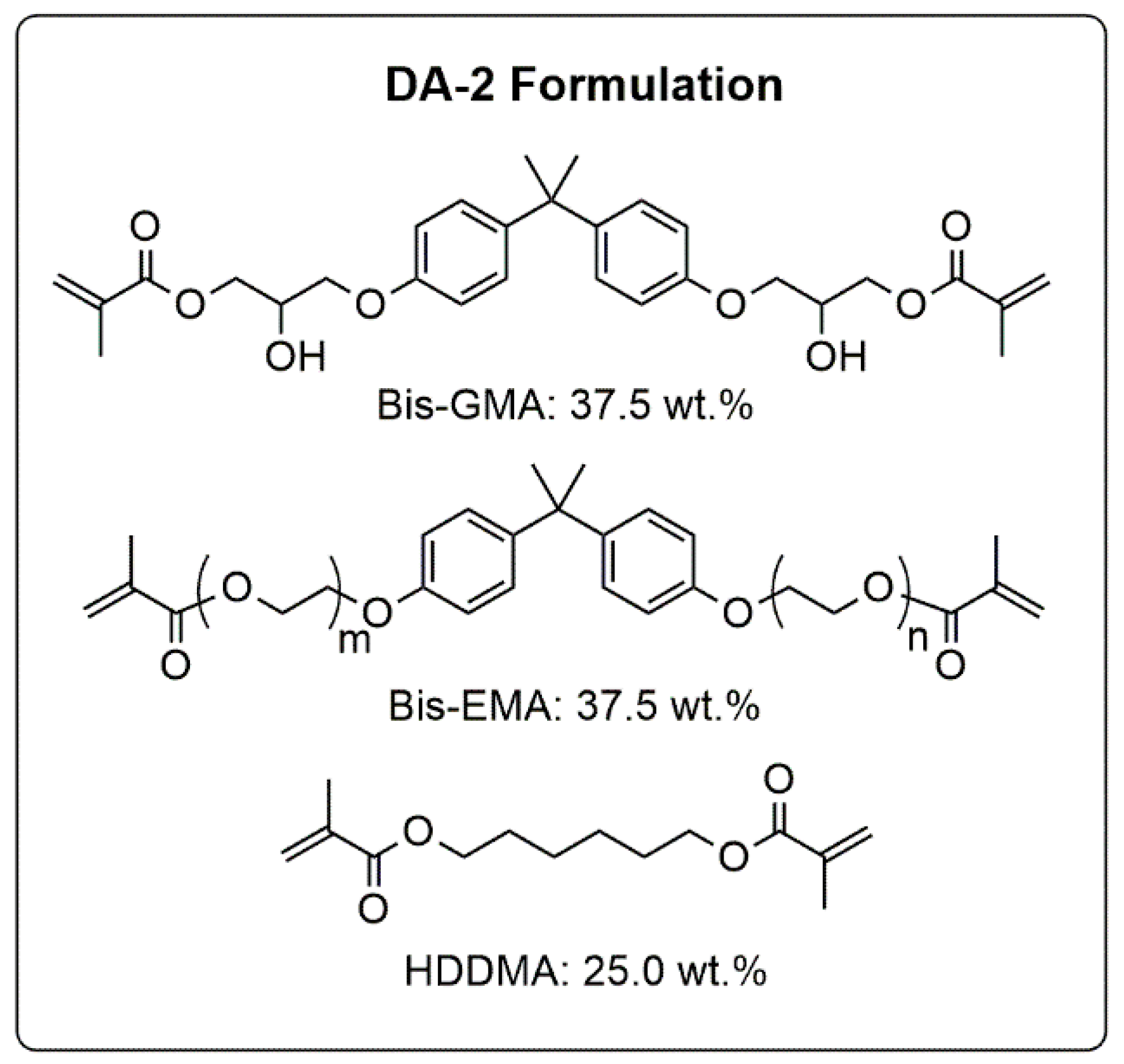1. Introduction
Three-dimensional (3D) printing is an additive manufacturing process in which successive layers of material are patterned and combined to form 3D shapes. 3D printing technologies are currently experiencing financial growth and are being increasingly adopted across industries. Factors driving this market growth are aggressive research and development and the growing demand for prototyping applications from industries such as healthcare, automotive, defense, and aerospace [
1]. In fact, the aerospace 3D printing market was estimated to be USD 1.86 billion as of 2019—only 16.8% of the total 3D printing market—and is expected to grow annually at a rate of 16.9% over the next 7 years to reach USD 6.72 billion in 2027 [
2]. For 3D patterning polymeric materials, extrusion or melt type techniques, such as fused deposition modelling and selective laser sintering, are common methods for the fabrication of thermoplastic parts. However, these techniques have the drawback of comparatively low resolution, weak layer adhesion, and slow processing. On the other hand, in light-based methods, the printing resolution and production speed are drastically improved due to the exceptional spatial control and versatility of photo-polymerization reactions [
3]. Moreover, the mechanical properties of the printed objects are significantly enhanced due to better layer-to-layer cohesion. Thus, light-based technologies offer attractive routes for 3D printing of polymers and composites. Examples of technologies include stereolithography (SLA), digital light processing (DLP), and continuous liquid interface production (CLIP) [
4,
5,
6]. In SLA, specific surface regions of photo-sensitive liquid resin undergo localized polymerization by exposure to a scanning spot light source. In DLP, all given portions of a layer are simultaneously photocured, significantly reducing part production times. The recently developed CLIP process utilizes a continuous building strategy, which further increases part production speed and enhances surface finish.
Light-based methods use photo-sensitive resins that can be cured by a light source, often a UV laser. Typical materials used are acrylic and epoxy resins. Currently, most standard photo-polymerizable resin formulations on the market produce parts with relatively low thermal and mechanical properties and, therefore, cannot be used for additive manufacturing of high-performance composite materials. Moreover, the compositions of commercial resins are proprietary information in most formulations. A list of commercial resins from reputable suppliers and their property information can be found in
Table A1 in
Appendix A. To develop a fundamental understanding of the processing-property relationships underlying light-based 3D printing methods, a well-defined additive manufacturing resin formulation is needed to serve as the benchmark resin system. A standard resin formulation should have the following characteristics [
7]: (i) commercially available component monomers; (ii) good storage stability including long resin shelf life and low monomer volatility; (iii) low viscosity for facile printing; (iv) good final part properties including good dimensional stability and high thermal and mechanical properties.
Bisphenol A glycerolate dimethacrylate (Bis-GMA), also known as the vinyl ester of diglycidyl ether of bisphenol A (VE-DGEBA), is a major component commonly used in dental formulations and in vinyl ester resins [
8,
9,
10]. Due to the presence of rigid bisphenol-A core in the backbones, the molecule imparts excellent performance characteristics to its final products. The strong intermolecular interactions by hydroxyl groups, however, result in an extremely viscous resin at room temperature [
11], so the use of diluent co-monomers becomes necessary for easy handling [
12]. Styrene is the most common comonomer in vinyl ester resins, but it cannot be used for 3D printing because it is a hazardous air pollutant (HAP) and a volatile organic compound (VOC, vapor pressure at 25 °C is 6.5 mmHg) [
10,
13,
14]. On the other hand, triethylene glycol dimethacrylate (TEGDMA) has been widely used as a comonomer of Bis-GMA in dental formulations. It significantly reduces the viscosity of the mixture and increases the polymer degree of conversion [
15]. However, the addition of TEGDMA causes an undesirable increase in polymerization shrinkage due to its higher double bond concentration and increased overall double bond conversion [
16,
17]. Neat TEGMDA can shrink by 12.3% compared to 5.2% shrinkage of Bis-GMA after polymerization [
18]. For this reason, low viscosity monomers with higher molecular weights were developed to decrease polymerization shrinkage and improve processability. To this end, ethoxylated bisphenol A dimethacrylate (Bis-EMA) has been present in several commercial formulations, partially or totally replacing TEGDMA [
19,
20]. The molecular structure of Bis-EMA monomer is almost the same as Bis-GMA monomer, except for the absence of hydroxyl groups. It shows intrinsically low viscosity due to the absence of hydroxyl groups that form hydrogen bonding. The lack of hydroxyl groups also results in a more hydrophobic molecule, which makes Bis-EMA suitable for applications where moisture uptake is undesirable. The equilibrium water uptake of neat Bis-EMA polymer is only around 0.6~1.8%, as compared to 2.5~3.1% for Bis-GMA polymer and 6.0~6.3% for TEGDMA polymer [
18,
21,
22].
This work describes the design of a well-defined benchmark resin formulation that in the future will be used to investigate the processing-property relationships in 3D printing. The screening process for resin development was primarily based on viscosity and glass transition temperature (Tg) considerations. Predictive models, namely the Grunberg–Nissan model for resin viscosity and the Fox equation for polymer Tg, were used as guiding tools to determine proper monomer ratios. The preference of di-functional reactive diluents over mono-functional is emphasized in terms of dimensional stability. The benchmark resin formulation is presented and fully characterized herein.
3. Results and Discussion
In many resin formulations, the preferred major component is Bis-GMA resin because of its good final properties. The addition of Bis-EMA resin maintains a low cure shrinkage, but also reduces resin viscosity and final material moisture sensitivity significantly. In this work, a combination of Bis-GMA and Bis-EMA served as the base resin of the formulations. A reactive diluent is needed to further reduce the viscosity to make suitable formulations for DLP printing. Two reactive diluents, isobornyl methacrylate (IBMA) and 1,6-hexanediol dimethacrylate (HDDMA), were selected for the study after screening. HDDMA had been used in this research group as a reactive diluent in vinyl-ester resins [
13]. HDDMA is known for its hydrophobic nature. A photo-cured polymer network containing HDDMA was found to uptake three to four times less water compared to the corresponding network containing the same amount of TEGDMA [
28]. IBMA was selected for the high
Tg of its polymer [
29,
30,
31,
32]. Both diluents have high boiling points (258 °C for IBMA and 315 °C for HDDMA) and low vapor pressures (0.01 mmHg at 25 °C for IBMA and 0.02 mmHg at 100 °C for HDDMA) [
33,
34]. The use of monomers with low vapor pressures is essential for a safe work environment and minimizes the composition drift due to possible monomer evaporation during printings.
Table 1 summarizes the measured room temperature viscosities of the component monomers, and the
Tgs of corresponding neat polymers available from the literature.
Predictive models for resin viscosity and polymer
Tg were used as guiding tools to determine proper monomer ratios. The Fox equation, shown in Equation (1), has been widely used to predict the
Tg of a polymer mixture based on the
Tgs of the neat components [
42]:
where
Tg,i and
ωi are the glass transition temperature and the mass fraction of component
i, respectively. The simplest model for predicting the viscosity of liquid mixtures is the Arrhenius equation [
43], but the additive model neglects thermodynamic parameters characteristic of the interactions between components and results in inaccurate predictions. The Grunberg–Nissan model, based on a modification of the Arrhenius equation to account for the excess free energy of mixing, shown in Equation (2), is commonly used to describe the viscosity of liquid mixtures [
44,
45,
46]:
where
η is the viscosity of a mixture,
ηi and
xi are the viscosity and the mole fraction of each component in the mixture, respectively, and
Gij is an interaction parameter dependent on the components and temperature. A negative value of
Gij indicates favorable mixing.
Binary interaction parameters
Gij were determined from the viscosity measurements of binary liquid mixtures of the monomers and calculated using Equation (2). The interaction parameters are found to be relatively constant with regards to monomer mixing ratios (see
Table A2).
Table 2 lists the averaged interaction parameters between Bis-GMA and Bis-EMA; Bis-GMA and a reactive diluent; and Bis-EMA and a reactive diluent such as
G12,
G13, and
G23, respectively. The interaction parameters show that Bis-GMA mixed favorably with Bis-EMA and HDDMA, but IBMA did not efficiently mix with Bis-GMA or Bis-EMA, likely due to the bulky nature of the isobornyl group that hinders flow [
47]. Interestingly, the excess free energy of mixing is close to zero when mixing Bis-EMA with HDDMA.
Figure 1a,b, shows the predictions of viscosity and the
Tg of final cured material using the Grunberg–Nissan model and the Fox equation, respectively, for ternary mixture system Bis-GMA/Bis-EMA/HDDMA. In
Figure 1a, the shaded area denotes a predicted viscosity ≤500 cP. In
Figure 1b, the shaded area denotes a predicted final
Tg higher than 150 °C.
Figure 1c,d show the overlap area where the predicted viscosity is lower than 500 cP and
Tg is higher than 150 °C. The same graphs for Bis-GMA/Bis-EMA/IBMA system are shown in
Figure A1 (
Appendix C). Note the slightly higher cut-off viscosity, 600 cP. For the
Tg predictions, the final
Tgs of Bis-GMA, BisEMA, and IBMA polymers are 200 °C, 160 °C, and 140 °C, respectively [
29,
30,
31,
32,
35,
36,
37,
38,
39]. The
Tg of the HDDMA polymer is not commonly reported in the literature, but it should be higher than the
Tg of its acrylate counterpart, 1,6-hexanediol diacrylate (HDDA), which was reported to be 93 °C [
29,
40]. Only one reference [
41] reported 150 °C
Tg for the HDDMA polymer. To be conservative, the final
Tg of HDDMA polymer is assumed to be 110 °C for predictive calculations.
Tg is a primary consideration only once the viscosity values are satisfactory for facile 3D printing. In the predicted overlap areas shown in
Figure 1c,d, higher
Tgs appears on the high viscosity side. Additionally, other factors need to be considered to obtain optimal material properties. Bis-EMA polymer has a relatively low Young’s modulus, typically less than 2 GPa [
22,
48]. Also, impact resistance was reported to decrease as Bis-EMA was added to the Bis-GMA/Bis-EMA copolymer [
49]. This can be explained by the decrease in the overall strength of intermolecular interactions; as the hydroxyl group concentration decreases, the number of physical crosslinking sites is reduced. On the other hand, if the Bis-GMA content is increased, more reactive diluent is needed, which will increase cure shrinkage. Therefore, to retain mechanical performance and minimize cure shrinkage, the formulations at the center of the high viscosity side of the overlap areas were selected for this study. These two formulations are called DA-1 and DA-2. Given in
Table 3, DA-1 consists of Bis-GMA 33.3 wt.%, Bis-EMA 33.3 wt.%, and IBMA 33.3 wt.%, and DA-2 consists of Bis-GMA 37.5 wt.%, Bis-EMA 37.5 wt.%, and HDDMA 25 wt.%. The predicted viscosities for the DA-1 and DA-2 resins based on the Grunberg–Nissan model are 620 cP and 450 cP, respectively. Rheological measurements showed DA-1 and DA-2 have viscosity values of 580 ± 40 cP and 490 ± 50 cP, respectively. The values are summarized in
Table 4.
DA-1 and DA-2 green parts were printed using the default print settings (100 μm layer thickness and 100 s exposure time). Green parts created by room temperature DLP printing often need to be post-cured to promote additional conversion. The post-cure process is especially necessary for parts printed with high
Tg resins because these resins reach vitrification at low monomer conversions under the printing temperature [
50]. When a DA-1 green part was directly placed in a conventional oven for thermal post-cure, cracks developed throughout the part (shown in the right picture of
Figure 2) and some delamination was observed between layers. This is due to the unreacted monofunctional isobornyl methacrylate molecules, which diffuse out before they can react because the thermal activation of the methacrylate double bond reaction is relatively slow [
47]. Such cracking and delamination phenomena would not happen if mono-functional monomers of higher reactivity were used, such as
p-methyl styrene and
N-vinylpyrrolidone. Another way to overcome this problem is to use multifunctional (≥2) monomers, proved by the case of DA-2. Direct thermal post-cure of DA-2 green parts did not cause cracks or delamination because most unreacted reactive diluent functionality exist as dangling chain ends. For this reason, the DA-2 formulation was chosen as the standard resin for the study.
The fractional monomer conversion,
α, is determined using Equation (3) from the decreasing integral of the characteristic near-IR absorption band of the methacrylate double bond, shown in
Figure 3 [
51]:
where
A0 and
A1 are the area integrals of the absorption band from 6225–6105 cm
−1 of the pristine resin and cured sample, respectively. Note that the calculated conversion is based on the absorbance averaged over the thickness of the tested sample. The fractional conversion is 0.67 for a DA-2 green part.
Figure 4 shows the DMA thermogram of a DA-2 green part with a
Tg of 22 °C identified as the peak of loss modulus,
E″. The
Tg value indicates that the vitrification conversion of the DA-2 resin is around 0.67 at room temperature. The tan δ curve shows a bimodal glass transition with a slightly more intense peak at 64 °C and a very broad second one at 120 °C. The
E″ curve also shows a shoulder above the main transition. Though this might be interpreted as a heterogeneous network morphology or spatial inhomogeneity of reaction, the likely cause of the behavior is a dark reaction by trapped radicals upon heating past the first
Tg resulting in partial revitrification and devitrification upon continued heating. The slight plateau in
E′ following the first transition supports this explanation. After post-processing, the fractional conversion becomes 0.88.
Figure 5 shows the DMA thermogram of a fully post-cured DA-2 sample. Based on three DMA tests, the
Tg of post-cured DA-2 material is 97 ± 3 °C and 165 ± 4 °C, identified as the maxima of loss modulus
E″ and of tan
δ, respectively. The latter number agrees with the predicted 160 °C
Tg via the Fox equation.
Successful printing of objects by stereolithography requires predetermined knowledge of the photo-curing properties of the starting material. Principles laid out by Jacobs to describe the photo-polymerization process were used to create a working curve that provides two key parameters that govern the polymerization of a photo-sensitive resin: depth of penetration,
Dp, and critical energy of polymerization,
Ec [
52]. Knowing
Dp and
Ec allows users to choose the appropriate settings for light exposure and z-axis increments, which optimizes the curing conditions to achieve the desired results. Here, the working curve is constructed for the DA-2 resin with 0.7 wt.% PPO photo-initiator, shown in
Figure 6. Under irradiation wavelength of 405 nm, the depth of penetration
Dp is 550 ± 55 µm and the critical energy
Ec is 5.6 ± 0.5 mJ/cm
2. The DA-2 resin has a large
Dp, which enables it to 3D print fiber-reinforced composite structures. The depth of penetration can be reduced by adding photo absorbers to allow for a better printing resolution.
The DA-2 resin’s density is 1.105 ± 0.001 g/cm
3, and the cured DA-2 material (fractional conversion: 0.88) has a density of 1.200 ± 0.002 g/cm
3. Cure shrinkage is, therefore, calculated based on the shrinkage in specific volume to be 7.9%. The tensile, flexural, and fracture toughness properties are measured for the fully cured DA-2 material.
Table 5 and
Scheme 2 summarize the properties and the composition information of the DA-2 material. Compared to the commercial resins shown in
Table A1, DA-2 is a strong material with an elastic modulus around 3 GPa and a flexural strength over 100 MPa. It has a low viscosity and a high depth of penetration for blue light curing, both of which make the resin suitable for the additive manufacturing of fiber-reinforced composites. DA-2 has a comparatively low fracture toughness that is typical of free radical polymerization systems. Future work will focus on improving the fracture toughness of the resin, studying the effects of 3D printing parameters, as well as understanding the processing-property relationships in light-based 3D printing technologies.
